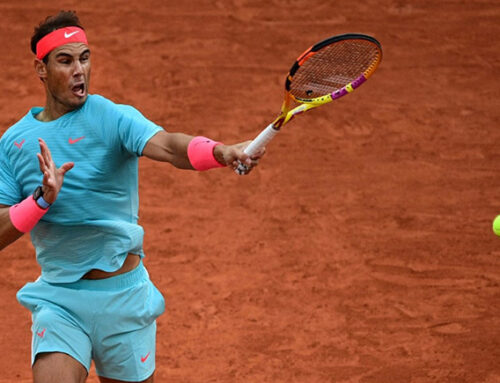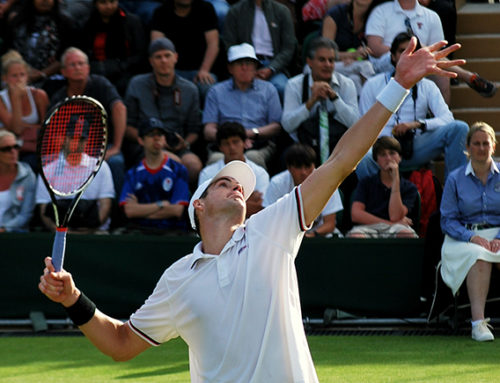Introduction
There is no scientific formula for the perfect serve. The serve is possibly the most complex biomechanical movement in tennis. When we consider that every individual comes to the table with their own unique functional movement patterns, the idea of ‘perfect’ quickly goes out the window. Two people of the same height may have different length arms, legs and torso. Athletes bring their own injury history to the table. Their range of motion will be different across various joints and in different directions. The short of it is no two people are identical in terms of their mobility and physical capacity.
While we might surrender the idea of a universally ‘perfect’ service motion, what we can do is identify the guiding principles that help people develop the best service motion for them. We begin by looking at the ball toss because the toss location influences what the underlying philosophy on what our serve will be. Perhaps no single aspect of a fully developed service motion is so variable and subject to so much debate. Poor toss placement limits our ability to hit different types of spin, to achieve disguise, and also limits the amount of energy we can reliably put into the ball. The toss is a boundary that will affect every other aspect of a service motion if done poorly.
Power And Consistency
Traditionally, for those of us who aren’t 6’9 serving has been considered a constant balancing act between power and consistency. This war between the two has largely come about due to misunderstandings on where the power in the serve comes from. It is this misunderstanding we aim to address (and hopefully correct) as we work through the various principles of a great service motion.
Power comes from two things – the speed of the racquet head at contact, and the amount of that energy that is transferred into the ball. The higher both of these numbers, the faster the serve will go. Consistency is more complex. It is affected by the repeatability of the motion itself, neurological ‘aiming’, and other things. Regardless, there is one simple concept that impacts consistency universally – the higher the point of contact, the higher the capacity for consistency with any given service motion. This last is the aspect we can impact with ball toss.
In summary, we want to get the racquet moving very quickly, we want to transfer as much energy as possible into the ball, and we want to do so as high above the ground as possible. What does this mean in terms of the ball toss?
What Do Elite Servers Do?
For this article we will look at the serves (specifically the tosses) of four players: Federer, Isner, Raonic, and Kyrgios. Each of them has a phenomenal serve. Importantly, we are dealing with players whose height ranges from 6’1 (Roger Federer) to 6’9 (John Isner). First we’ll take a look at what their toss is like at contact. Next we’ll put some numbers to what they are doing. Finally, we’ll talk about the why of it all. And why what you’ve always thought about ball tosses is probably wrong.
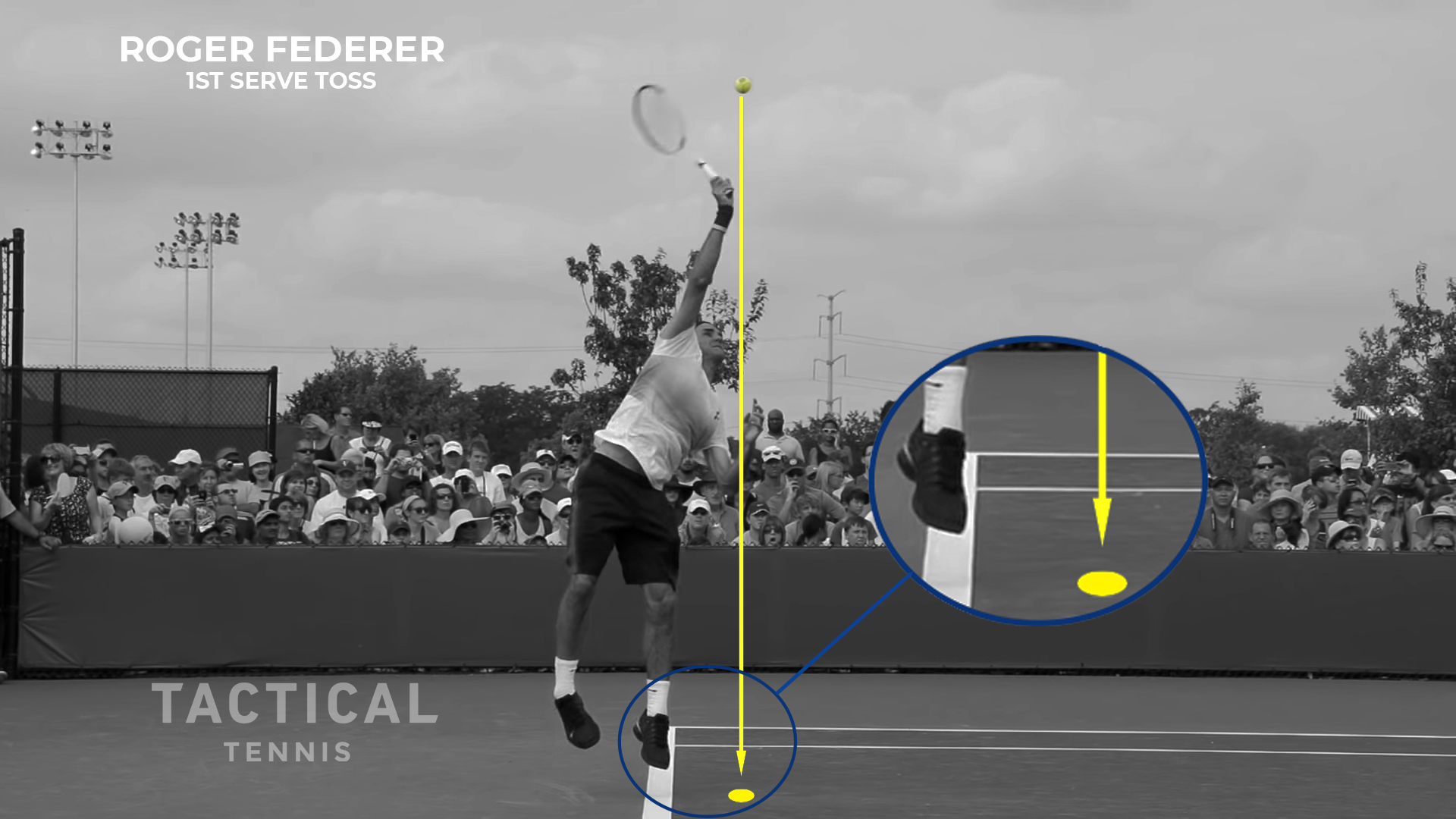
Federer is known for serving with both accuracy and disguise. What is often overlooked is his ‘flat’ serve clocks in at around 125 mph. Roger generates such easy power, which is a big part of why he is able to be so precise. At the point of contact, Federer’s toss is barely in front of him on the first serve. What about on the second serve?

We can see that Federer’s toss is even closer to the baseline on his kick serve than it was on his first serve. The angle of attack into the ball is different on this serve, in part due to the change in ball toss location.
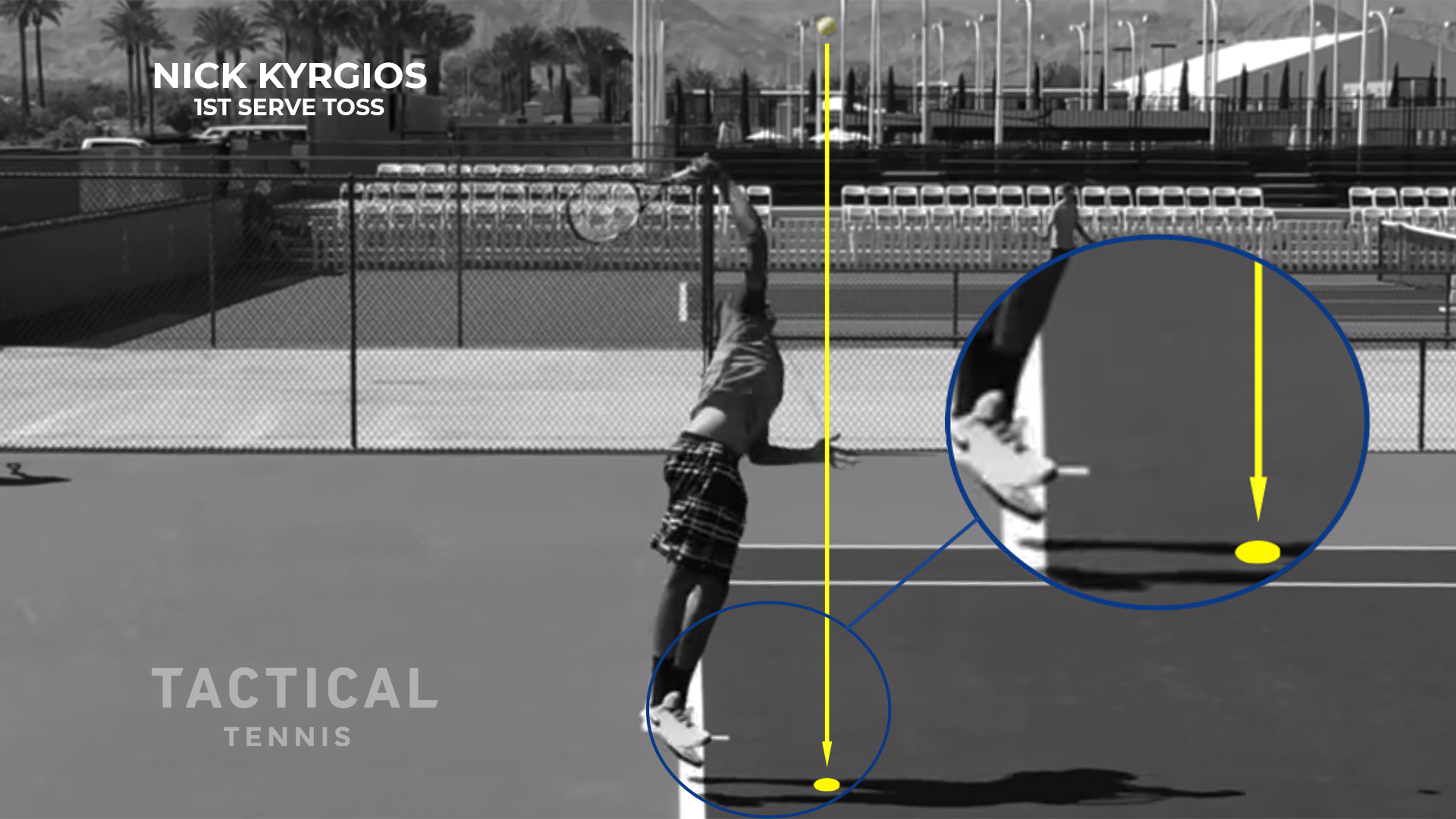
6’4 Nick Kyrgios tosses the ball slightly further into the court than Federer, but is also 3-4 inches taller. We can still see that the toss is far more upwards than it is outwards.

Roanic’s toss appears to be slightly closer to the baseline than Kyrgios’, yet slightly further out than Roger’s. At 6’5, he is the second-tallest of those whose serves we will be examining.

Last but certainly not least, we have John Isner. His toss is further into the court yet, but it is important to remember that he stands a towering 6’9!
Angles, Not Distance
Ultimately, the distances don’t really matter. Or rather, the distances only matter in the context of how high the point of contact is on the serve! As the contact point becomes higher and higher, it allows for more and more projection into the court towards the net. Let’s go back and check the angles on those serves that we already examined.
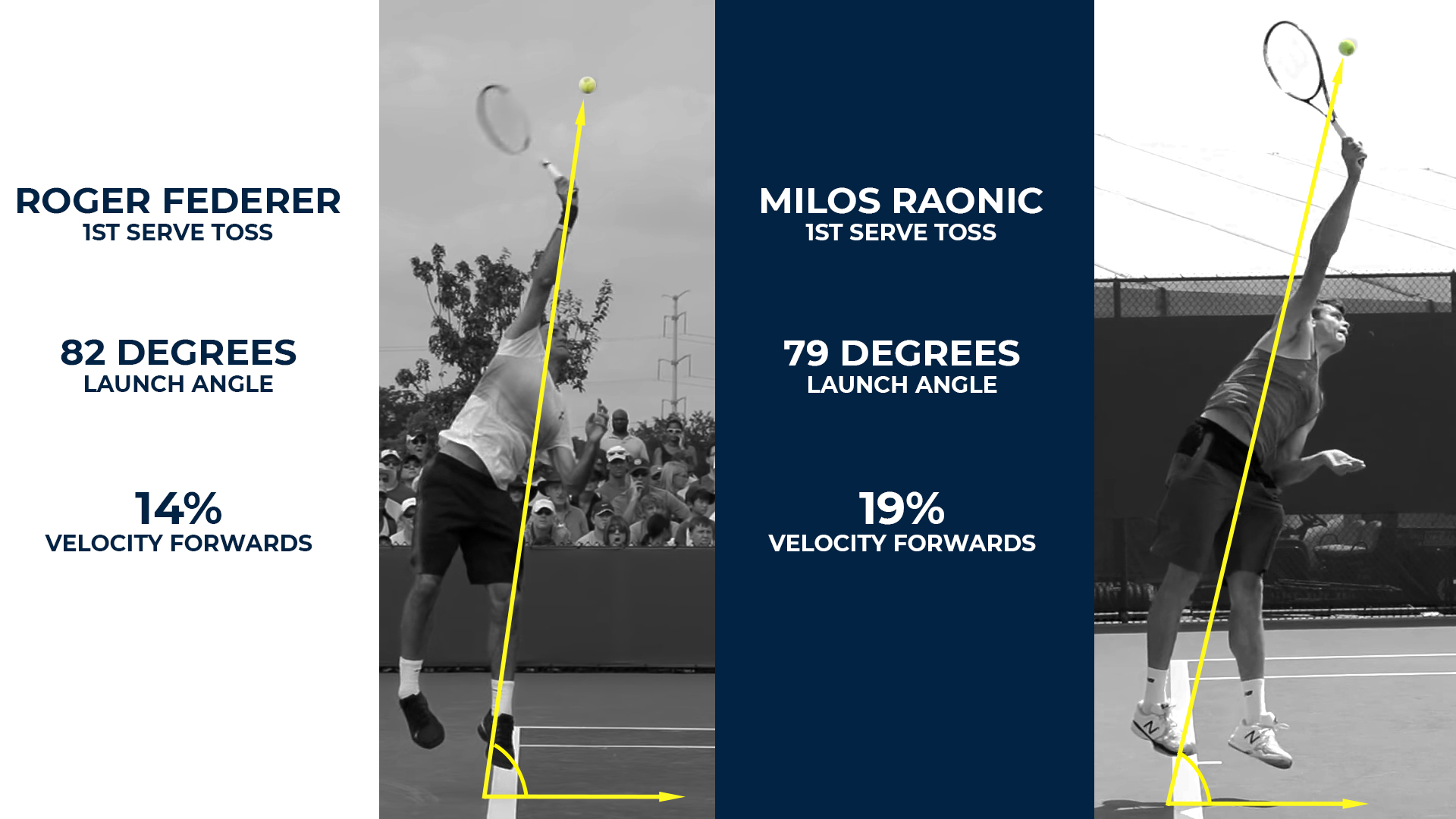
Federer is the most upright of the players that we’ll examine. On his first serve the ball is at roughly 82 degrees from his launch position on the baseline. As noted in the image, this means only 14% of the velocity from his jump is going ‘forward’ into the court. 99% of the velocity goes upwards (thanks to trigonometry, these two numbers don’t need to add up to 100%).
Raonic’s toss is at a slightly lower angle. His 79 degree launch angle means 19% of his jumping velocity is into the court (and 98% upwards). Give his 4″ height advantage over Federer, he can afford to surrender a small amount of height and toss the ball slightly further forwards
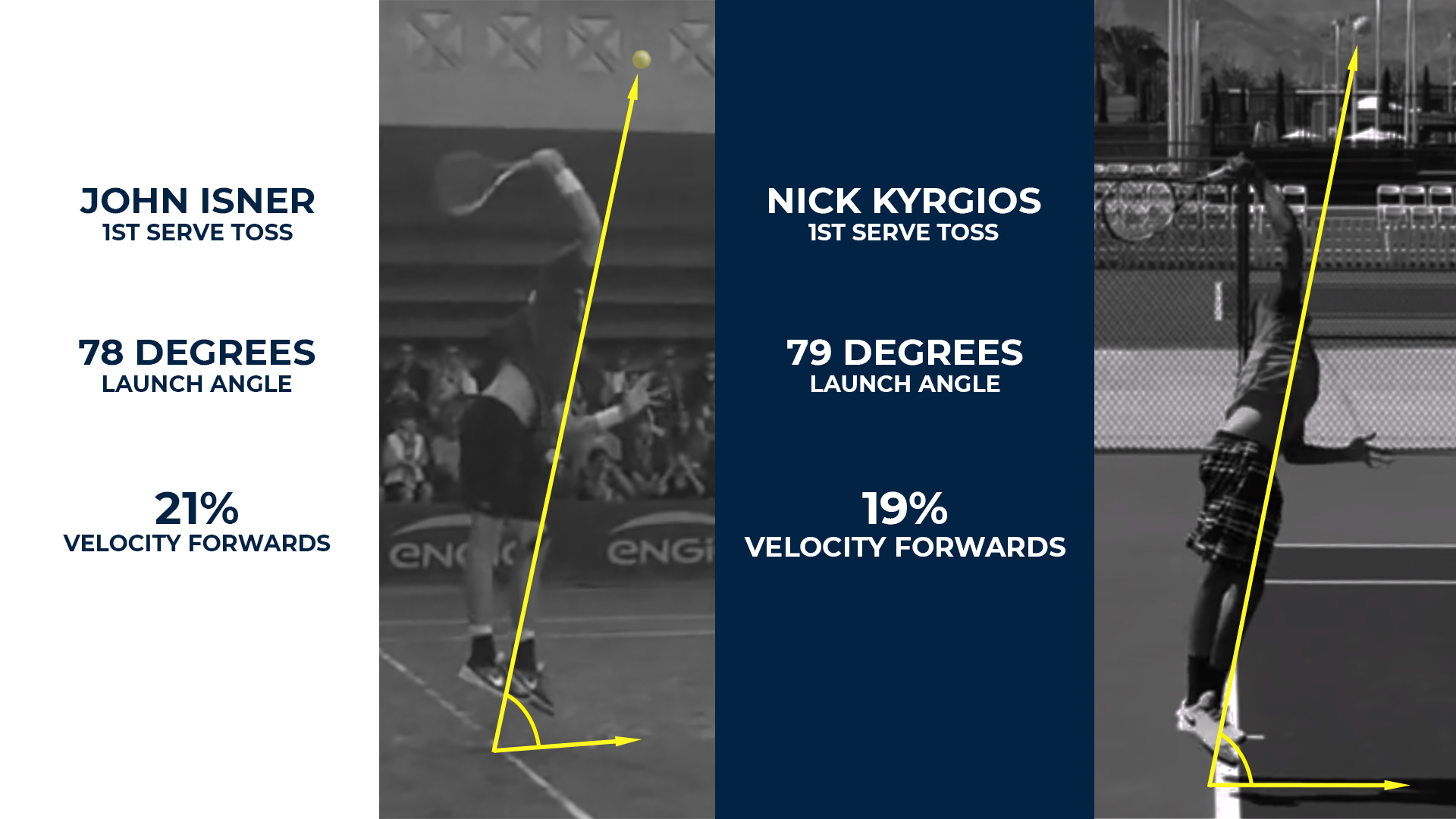
We see Isner and Kyrgios with almost identical launch angles. Isner’s 78 degrees nets him 21% of his jumping velocity forwards, which Kyrgios’ 79 degree launch angle matches Raonic’s and also puts around 19% forwards. It probably isn’t coincidence that three of the greatest servers in the history of the sport all have 78-79 degree angles for the point of contact on their first serve – regardless of their height. It might also not be coincidence that the only 6’1 server in the modern game to even come close to these three giants has a steeper angle at 82 degrees.
There is a critical idea here related to height, distance, and angle. A 6’9 player at 78 degrees (such as Isner) will inevitably make contact further into the court from a pure distance perspective than a 6’1 player with the same launch angle unless the 6’1 player jumps so high as to match the contact height of the taller player. This doesn’t mean tossing further into the court is better! It does mean we should focus on an optimal body position at contact, and use a toss that enables that. This angle is much more upright than most people realize. It is also possible that even the angles of Isner, Raonic, and Kyrgios might not be quite ideal!
Jumping Forward And Power (Math Time!)
The common dogma/myth in tennis serving is that we need to jump into the court for power. There is, as it turns out, some advantage to being closer to the net at the point of contact when we serve. However that advantage cannot come at the cost of decreased height at contact if we want to be an elite server. In truth, the idea that power comes from tossing the ball further into the court is based on a fundamental misunderstanding of where power actually comes from.
This is where we get to the math/physics portion. If we assume a player jumps 12 inches (30 cm) off the ground in their service motion, some good old fashioned math tells us they are traveling at around 2.5 m/s (roughly 5.5 mph). Now remember from above, the majority of this velocity is straight upwards – only a small portion is forwards into the court. At the peak of their jump, all of the server’s upwards velocity has halted (thanks gravity). Their forward momentum hasn’t stopped though. They are still moving into the court at around the same speed they were when they left the ground.
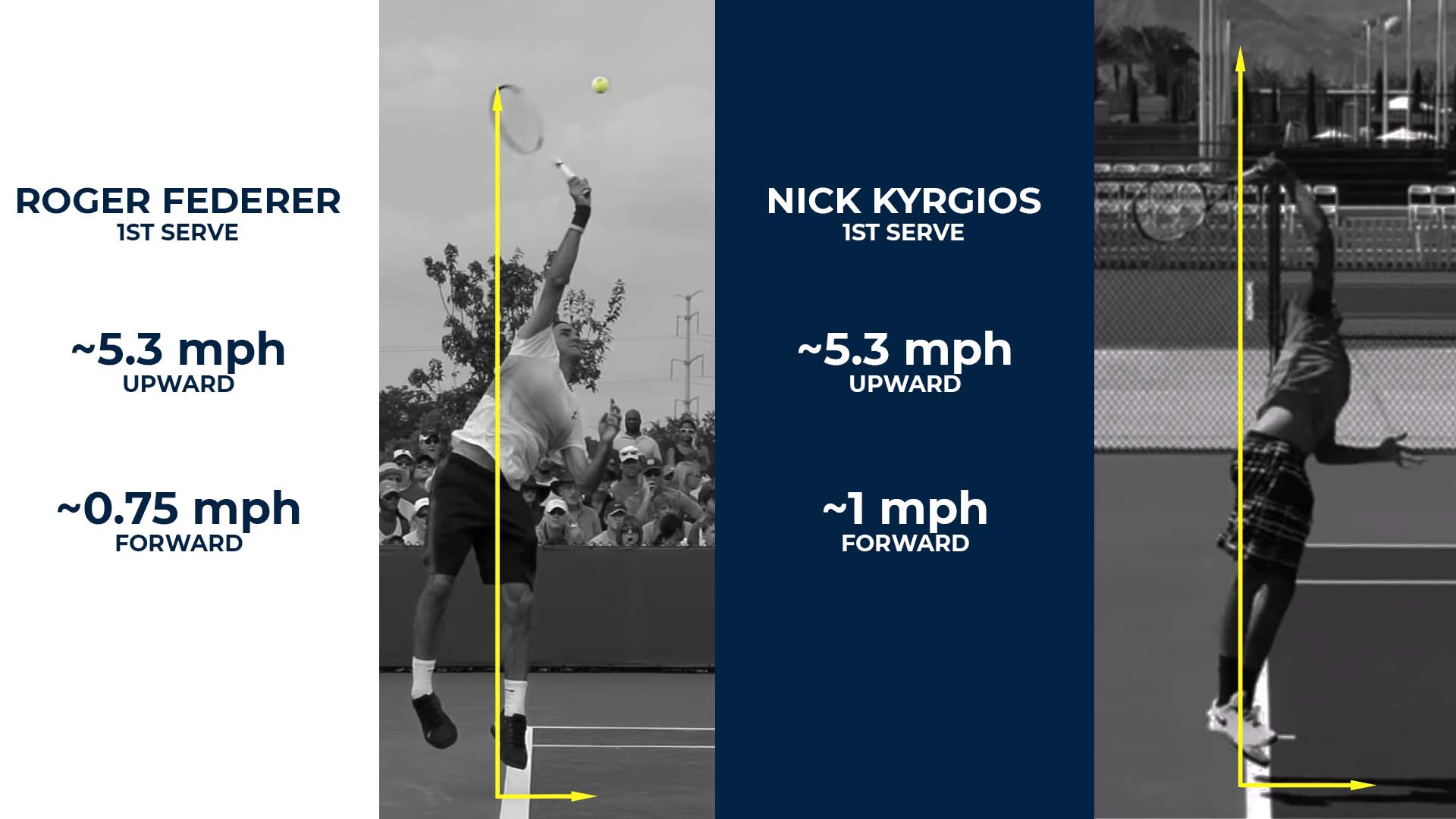
For Federer, this means his forward velocity on his jump is about 0.75 mph. For Nick Kyrgios, it’s 1 mph. To put that in perspect, the walking speed of an average sized adult is around 3 mph.
If jumping forward is so important for power, how does having your body moving at 1/3 of walking speed make a difference on a 130 mph serve? How could this 1 mph possibly matter?
The short answer is, of course, that it doesn’t matter at all.
Jump And Toss For Height (Not Power)
We can probably agree that making contact higher in the air is beneficial. If you had any doubts, consider that top three aces per match in ATP history are Reilly Opelka (6’11), Ivo Karlovic (6’10), and John Isner (6’9). That’s probably not a coincidence. We know that being higher at contact improves not only our consistency on the serve, but also our ability to serve aggressively. Conversely, the lower we are at contact, the less margin for error we have.
We’ve established that the jumping only adds approximately 1 mph of body momentum to the serve. This could potentially be increased by tossing further into the court. Increasing the toss angle to 65 degrees would double our forwards jumping speed to a massive 2 mph. Critically, doing so would decrease the height at contact by 12 inches! Does this seem like an equitable trade-off?
When it comes to the position of the toss relative to the baseline, the primary goal should be height, not forward momentum. It is true that we want the toss in front of our body, in order to be able to hit a biomechanically sound serve. But beyond a bare minimum of 4 to 12 inches (10-30 cm), tossing further forward decreases our serving effectiveness by reducing the height of the ball at contact.
Other Considerations
For someone who plays serve and volley tennis, there are other advantages to tossing the ball forward than adding a negligible amount of velocity. Landing 2 feet closer to the net puts one, well, 2 feet closer to the net. That can be the difference between playing a regular volley or a half-volley for the first follow-up shot after the serve. There is also the matter of having more forward momentum on landing. Being able to continue a forward motion gets one to the net more quickly than jumping completely vertically, landing, and then accelerating forwards.
These are very real considerations for a serve-and-volley player. The key point is understanding the trade-off that we are making if we choose to toss the ball further forward. Our serve will be less effective, but we get to the net a little more quickly.
First Serve versus Second Serve
The main difference between what most players hit for a first serve versus a second serve is the prioritizing of spin over velocity. This necessitates a difference in approach vectors of the racquet towards the ball. That is the trade-off when we consider kick serves over slice or ‘flat’ serves. It isn’t that Federer swings slower on his kick serve than his first serve. His goal is to put just as much energy into the ball. Rather, more of that energy goes into rotational energy (spin) instead of kinetic energy (velocity).
What does this look like in terms of toss position for Federer?

Federer has a steeper angle of approach to the second serve toss, which is placed slightly closer to him than the first serve toss. With spin being a huge focus, his goal is to put energy into the ball in a more upwards vector, driving huge rotation of the ball.
Access To The Ball
This brings to light the final, and important concept. Our toss doesn’t just change the way that we jump. The position of the ball relative to our body changes which parts of the ball we can make contact with. As a simple example, when we toss the ball in front of us on a serve we cannot make contact with the side of the ball closest to the net. The toss location (and the desire to hit it towards the net) preclude that.
When the ball is largely directly above us, we have the capacity to strike the ball in many different places. We get to approach the ball with the racquet from a lot of angles. As the toss gets further and further into the court, the parts of the ball we have access to become smaller and smaller. This limits our ability to impart different spins on the ball! This also reduces our ability to create uncertainty in the receiver. If we can only hit one type of spin due to our toss, then they have one less thing to worry about.
What About Power?
Players make contact around the peak of their jump. At that peak, they are not traveling upwards at all, and forwards only at a fraction of walking speed. This isn’t exactly a great way to add power!
So if power on the serve doesn’t come from the leg drive, where does it come from?
We will cover this in an upcoming article on the serve. If you want to get started on figuring it out yourself, read the article on Shapovalov’s jumping backhand.
In the next article, we will look at the second part of ball tossing. We now know we should toss it fairly close to the baseline, but where on the baseline relative to our body should it be?
Appendix
We calculated the jumping velocity using kinetics formulas, then confirmed the numbers with energy calculations as follows:
Kinetic Calculation
Velocity at peak of jump = 0
Acceleration = -9.8 m/s^2
Distance = 0.3 m
Velocity = (Initial Velocity) + 2* (Acceleration)*(Distance)
0 m/s = (Initial Velocity) + 2* (-9.8 m/s^2) * (0.3 m)
Initial Velocity = -2 * (-9.8 m/s^2) * (0.3 m)
Initial Velocity = 2.42 m/s (5.41 mph)
Energy Calculation
Potential Energy at peak of jump is equal to the Kinetic Energy at the beginning of jump.
Taking Federer as example:
mass = 85 kg
gravity = 9.8 m/s^2
height = 0.3 m
P.E = mass*gravity*height
P.E = (85 kg) * (9.8 m/s^2) * (0.3 m)
P.E = 249.9 kgm^2/s^2
Kinetic Energy = 1/2 * (mass) * (velocity)^2
249.9 kgm^2/s^2 = 1/2 * (85 kg) * (velocity) ^2
velocity ^2 = 2*(249.9 kgm^2/s^2)/(85 kg)
velocity = 2.42 m/s


